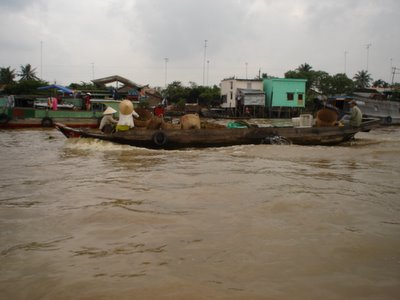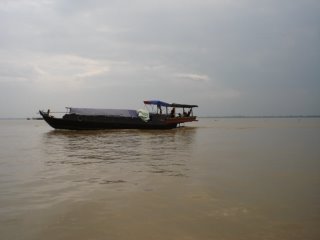
The Mekong Delta. If you are American, and of my generation or older, there is only one thing that comes to mind when you hear those words: war. Hearing the country name, “Vietnam”, often evokes the same thoughts, but since I have been here, those connections are less frequent. Yet I had not been able to escape the visceral response to Mekong Delta; images from the nightly news, stories from survivors on both sides, sections from movies. But I also knew that it was a beautiful area with a unique way of life and I wanted to see it. So yesterday I took another day trip, this time to the Mekong Delta.
“The bus leaves at 7:30”, I was told by the woman at the tour office. The bus from where I live to the center of town takes 20 minutes at that time of the morning, then it’s a short taxi ride over to where I’d get the tour bus. There should be enough time, especially considering that my last trip with these people left 40 minutes later than we had been told. But I knew I would freak the whole way there thinking that I might miss the tour, so I took a taxi and got there at 7:20am. We finally left around 8:00.
Our mid-sized bus had 30 people fully packed in. We were an international group; Australians, Koreans, Vietnamese, New Zealanders, British, Taiwanese. I sat next to a young Vietnamese woman who was home on holiday from studying in Australia. Like we do in our own countries, she had never been to the Delta region.
Our guide was a jovial man in his mid-30’s. As we headed out of town, he told us about the various produce grown in the Mekong. Pineapples, he assured us, “are very good for your health”. They cure skin problems, help you loose weight, help you sleep, and make you strong. Watermelons from the Mekong are also very good for your health. Eating three of the small ones is better than Viagra, he told us. As the day wore on, we were to hear that anything and everything in the Mekong, is “very good for your health”. By the end of the trip, most of the group would fill in those words before he had a chance to say them.
Looking out the bus window, I noticed we were heading back towards my apartment. You could actually see my building as we turned left onto the highway. I checked my watch; 8:15. Damn, I hadn’t needed to get up at 5:30; I could have just walked out and flagged down the bus at 8:00! I would remember this for trips in the future. Oh well, it was only an hour and a half to the Delta and out boat tour. I had chosen this trip over the three hour bus ride of the other option. However, I had been given misinformation. We wouldn’t reach the Delta and our boat until almost 11:00. If this was the ‘shorter’ trip, I didn’t want to think about the other trip I hadn’t chosen. One thing I can say about Vietnam, nothing goes for more than an hour and a half without a break. When I teach, we have to take a break every hour. On a bus, it stops every hour or hour and a half, relieving me of one of my greatest fears: the 3 hour trip with no bathroom stop.
Our guide assailed us with stories and songs and information about the areas we passed and the history of the Mekong. He had graduated form the university, but his father was still a rice farmer and he would go home to help harvest and drain rice paddies. I had noticed on my last trip that there seemed to be graves standing in the middle of the rice fields; one here, on there. He explained that in the countryside, people were buried where ever the geomancer tells them is a good spot. He further explained that in the north of the country, three years after a person is buried, they are exhumed, their remains but into a jar, which is then taken to the temple.
We passed through little towns and over cannels, and eventually arrived at the dock for the river boat we would board and tour in. It was a long, low slung affair, allowing you to ride right on the water. We sat on two-seated benches. A wooden roof covered our heads, but the rest was open-air. The day was rather grey, but that was probably preferable to insufferable jungle heat and humidity, and/or rain.
As we wound our way up the river we passed boats moving in both directions. Some were public transport, others carried produce from the Delta to Ho Chi Minh City. The boats were of the same basic design as ours; long and narrow, but in varying sizes. Some had only the pilot, others had up to five people either engaged in an activity or lying in hammocks. I was very pleased to see at least one boat with a lone woman at the helm. Our guide explained that most of the boat owners sometimes lived on the boats but also had a house on the land. The majority of work done by the boats in this region had to do with transporting produce and materials produced there. Fishing boats were in other areas.
Our first stop was at the coconut candy factory. We filed out of the boat and into an area that really was producing candy, but also arranged so that tourists could watch the process. I saw them make flat, paper-thin rice pancakes that you use as tortillas. (and when filled, they are delicious!) I watched the process for making coconut taffy. Every part of the coconut is used for one thing or another; the husk, the oil, the milk, the pulp, the shell. I skipped the sampling of cobra wine, (very good for your health), and will not even describe it to you. There were tables set up with piles of various candies to buy, as well as handicrafts. I knew we would only be there a short while, so went in search of purchases.

These trips are so cheap that I don’t know how they run them. The least I could do is to throw some money into the local economy. I ended up with wooden cooking spoons made from coconut shells, a purse made of a shell, (lined and with a zipper), and about one kilo of candy including taffy and crystallized ginger.
Again, I don’t know how the venders make much money as we are rushed through it all.
Walking further, we were taken to the puffed rice area. A giant cauldron hung over a fire. Inside were several pounds of blacked sand. Rice, still in its husk, is dumped into the burning hot sand, while the rice-tender quickly stirs it with a long pole. Within less than a minute, all the rice is puffed. He then dumps it into a sieve to separate the puffed rice from the husks. The husks are used in animal feed.
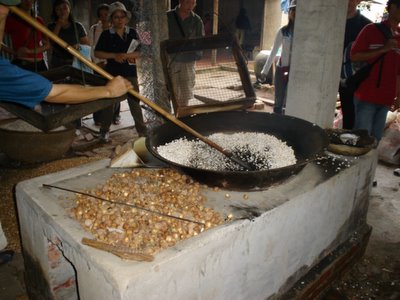
The rice is then mixed with caramelized sugar. Two men stand on either side of a giant vat, meter long mixing spatulas in each hand. With astounding grace and precision, they mix the concoction as if performing a ritual dance, moving in a slow circle around the pot, as they dig, scoop, pull there sticks up and shove them down again. It really was memorizing. Once they finished, the mixture is dumped onto a rectangular table with three in sides. It is rolled and flattened before being cut into squares.
Back on the boat, we soon reached what looked like the open sea. Getting back to that mental connection I have with the Mekong, I was surprised to see how wide it was. The guide said over one and a half kilometers. I keep thinking about the small canals I had always seen on the news or in movies. And wasn’t that John Kerry swift-boat film from the Mekong? Obviously, there was way more to this river than I had known. And it was also then that I realized I hadn’t been thinking WAR for over an hour. As the day passed, visions and thoughts of conflict drifted further and further from my mind, not by any conscious effort, but by the people and lives I saw around me.
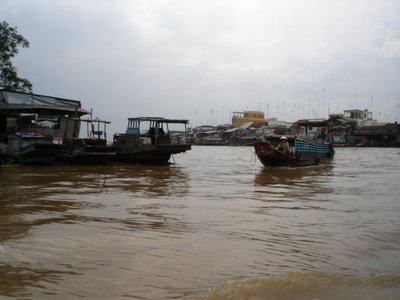
Up another narrow waterway, we docked at the lunch restaurant. I sat at what we dubbed the International Table. Me, a Korean couple, two ladies from Taiwan who had been in Vietnam on business, and to Vietnamese men. We ate fresh elephant ear fish that had been deep fried, (but not at all greasy), served standing on its side in a little stand. We ate it with those rice paper pancakes which you fill with mint, lettuce, noodles and vegetables, and dip in fish sauce. Fish sauce is on every table with every meal. It is made of sugar, lime, chilly, and something else. I love it. I threw MSG-caution to the wind, and dug in. twenty minutes later, I was stuffed and had a splitting headache, but it was worth it. I have never had such excellent fish.
We had another half hour before leaving, and were encouraged to grab a bike and take a turn around the neighborhood. I needed water and a seat. Our lunch had been included in the $7 tour and, again, I couldn’t understand how anyone could profit from this. I looked around for things to buy and only water was available. I did manage to take a short walk, while most of my fellow travelers hopped on bikes. I figured after all those hours of sitting on a bus, then in a boat, then eating, why spoil it with actually getting the blood moving?
We had one more stop on our trip and that was to the ceramics factory, where they make bricks and garden pots for both the local market and export. The factory is inside a building, but it’s a very simple structure, with openings in the roof to let in light. About eight, immense brick ovens lined the walls. After they are cut from clay, they are fired for three weeks.
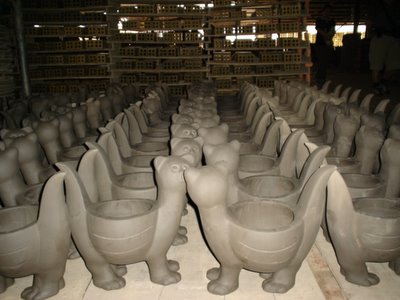
Walking on, we went into a giant warehouse of drying pottery. Only two people were working, making large planter pots in the shape of a cat. The clay, which is from the banks of the river, is sliced from a huge block. One person pounds and kneads it, rolls it out, and then it is pressed into a two-side mold. The team of two can make about ten of these large pots a day, working a ten hour day. They are quick and efficient, and are paid by the number of items produced. They are paid about 2 or 3 dollars a day. Keep that in mind the next time you buy are large, earthenware garden pot that is made in Vietnam.
We boarded the boat for the last time. Before taking off, we were each given a fresh coconut to drink. From a branch of coconuts, the boat pilot chopped off the bottom and top, stuck in a straw, and we drank as we cruised back up the delta.
It was 4:00, and I was not looking forward to another bus ride, but was happy to be heading back. This time, our bus was even smaller and I was wedged in over a wheel well. “OK”, said our guide, “We will be in Ho Chi Minh City in three hours”. What? I called out. It’s supposed to be an hour and a half! It turned out to be quite enjoyable. Across from me was a mother and daughter from New Zealand. Behind them, a father and daughter from Australia. Next to them, a couple also from Australia. We started pulling out the various snacks we had bought or brought with us, and passed them around. We exchanged stories, got travel tips from those who had been here a while, and later heard more stories from our guide.
Nearing the city, I realized I would not have to go back into town if they could just let me off at the turn off the freeway. I called out to our guide, who talked to the driver, and it was arranged. When the bus pulled over to let me off, I was a little sad to leave my new friends, and felt rushed giving my thanks to our charming guide who had put up will all my extra questions. Once out in the open air, I decided to walk home, even though it was pitch black. Everyone assures me it is safe and it was. The twenty minute walk really helped after that last, squished bus ride.
A long day, but a good one. Now, when I hear ‘The Mekong Delta,’ I may still have the old memories, but I will also have new, positive ones. And isn’t that what it is all about?
Happy Holidays to all
Kate
